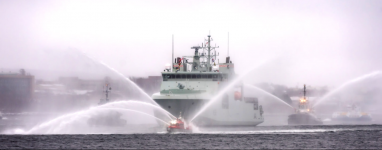There was an interesting comment made on one of RUSI's
Western Way of War podcasts (
Episode 71: Alessio Patalano: The Evolution of Warfare at Sea) which basically noted that the roles and requirements of a peacetime navy are quite different than the roles and requirements of a wartime navy and that all navies struggle to find that balance.
I think that perfectly describes the discussions we're seeing on this thread. AOPS and the MCDVs are quite suitably armed for their roles in a peacetime Navy. The roles they fulfill as non-combatant Navy vessels are very important to the political goals of Canada at peace and quite possibly some of those roles may not be politically suitable for a heavily armed warship. Most of those roles would also be significantly more expensive to be performed by combatant vessels as well (with many possible knock-on effects from that as well).
What we're seeing now is a period of heightened tensions globally where our thoughts are shifting further away from the requirements of our peacetime Navy and more to our potential need for a wartime Navy. That naturally means that we're questioning the mix we have of combatant vs non-combatant vessels in our fleet as well as the suitability of some of our vessels for a conflict. The balance becomes more difficult to find when you're dealing with a Navy as small as ours.
My personal opinion is that:
- Our Navy is too small in the first place (for either peacetime or wartime) for the size of our maritime domain and the role we profess to play in the world.
- With the potential for armed conflict seemingly increasing we need to (rapidly) begin shifting more toward a wartime (combatant heavy) Navy than the mix we currently have.
- We should be more thoughtful in our planning in the future by taking advantage of modularity, etc. in order to be able to up-arm (and down-arm) our ships in order to more quickly shift the peacetime-wartime balance of our fleet. Building completely new ships to face a changing environment simply takes too long (and is too expensive) and likely won't be quick enough to meet a suddenly changing need.





